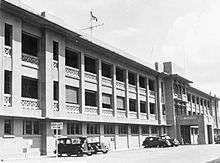China Station (Royal Navy)
The Commander-in-Chief, China Station was the admiral in command of what was usually known as the China Station, at once both a British Royal Navy naval formation and its admiral in command. It was created in 1865 and deactivated in 1941.

| China Station | |
|---|---|
 A British warship inside the Admiralty IX floating dry dock at Singapore Naval Base in September 1941 | |
| Active | 1865–1941 |
| Country | |
| Branch | |
| Type | Naval formation |
| Part of | Admiralty |
| Garrison/HQ | Singapore Naval Base (1865–1942, 1945–1971) HMS Tamar (1865–1941, 1945–1997) Wei Hai Wei station on Liugong Island (1898–1930) |
From 1831 to 1865, the East Indies Station and the China Station were a single command known as the East Indies and China Station.[1] The China Station, established in 1865, had as its area of responsibility the coasts of China and its navigable rivers, the western part of the Pacific Ocean, and the waters around the Dutch East Indies.[2] The navy often co-operated with British commercial interests in this area.
The formation had bases at Singapore (Singapore Naval Base), HMS Tamar (1865–1941 and 1945–1997) in Hong Kong and Wei Hai (at Liugong Island) (1898–1940). The China Station complement usually consisted of several older light cruisers and destroyers, and the Chinese rivers were patrolled by a flotilla of suitable, shallow-draught gunboats, referred to as "China gunboats".[3] Ships on this station usually had a distinctive livery of white hull and superstructure and dark funnels. In response to increased Japanese threats, the separate China Station was merged with the East Indies Station in December 1941 to form the Eastern Fleet.[4]
Commanders-in-Chief, China
| Dates | Admiral Commanding[1][5] |
|---|---|
| 1865–1867 | Vice-Admiral Sir George King |
| 1867–1869 | Vice-Admiral Sir Henry Keppel |
| 1869–1871 | Vice-Admiral Sir Henry Kellett |
| 1871–1874 | Vice-Admiral Sir Charles Shadwell |
| 1874–1877 | Vice-Admiral Sir Alfred Ryder |
| 1877–1878 | Vice-Admiral Sir Charles Hillyar |
| 1878–1881 | Vice-Admiral Robert Coote |
| 1881–1884 | Vice-Admiral Sir George Willes |
| 1884–1885 | Vice-Admiral Sir William Dowell |
| 1885–1887 | Vice-Admiral Sir Richard Hamilton |
| 1887–1890 | Vice-Admiral Sir Nowell Salmon |
| 1890–1892 | Vice-Admiral Sir Frederick Richards |
| 1892–1895 | Vice-Admiral Sir Edmund Fremantle |
| 1895–1897 | Vice-Admiral Sir Alexander Buller |
| 1897–1901 | Vice-Admiral Sir Edward Seymour |
| 1901–1904 | Vice-Admiral Sir Cyprian Bridge |
| 1904–1906 | Vice-Admiral Sir Gerard Noel |
| 1906–1908 | Vice-Admiral Sir Arthur Moore |
| 1908–1910 | Vice-Admiral Sir Hedworth Meux |
| 1910–1913 | Vice-Admiral Sir Alfred Winsloe |
| 1913–1915 | Vice-Admiral Sir Martyn Jerram |
| 1916–1917 | Vice-Admiral Sir William Grant |
| 1917–1919 | Rear-Admiral Sir Frederick Tudor |
| 24 July 1919 – 1922 | Vice-Admiral Sir Alexander Duff |
| 10 September 1922 – November 1924 | Admiral Sir Arthur Leveson |
| November 1924 – 1925 | Rear Admiral Sir Allan Everett |
| 1925 | Rear Admiral David Anderson (acting) |
| 22 April 1925 – 8 November 1926 | Vice-Admiral Sir Edwyn Alexander-Sinclair |
| 8 November 1926 – 28 November 1928 | Vice-Admiral Sir Reginald Tyrwhitt |
| 28 November 1928 – 28 February 1931 | Vice-Admiral Sir Arthur Waistell |
| 28 February 1931 – 11 March 1933 | Vice-Admiral Sir Howard Kelly |
| 11 March 1933 – 11 January 1936 | Admiral Sir Frederic Dreyer |
| 11 January 1936 – 5 February 1938 | Vice-Admiral Sir Charles Little |
| 5 February 1938 – 1940 | Admiral Sir Percy Noble |
| September 1940 – November 1941 | Vice Admiral Sir Geoffrey Layton |
| November – 2 December 1941 | Admiral Sir Tom Phillips [6] |
References
- William Loney RN
- Royal Navy Foreign Stations
- HMS Falcon Archived 2007-09-29 at the Wayback Machine
- "The sinking of HMS Prince of Wales and HMS Repulse". Archived from the original on 13 December 2016. Retrieved 26 September 2010.
- Paul Bevand; Frank Allen (21 October 2007). "Commander-in-Chief, China Station". Royal Navy Fleet Officers, 1904–1945. Archived from the original on 1 December 2008. Retrieved 4 July 2008.
- Jackson, Ashley (2006). The British Empire and the Second World War. London, England: A&C Black. pp. 288–289. ISBN 9780826440495.